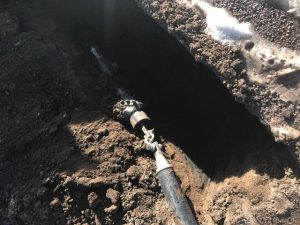Horizontal Remediation in the Southwest
Heading back to the southwest after the holiday break, DTD completed the installation of a horizontal remediation system in the high plains. The original scope included the installation of four horizontal soil vapor extraction (SVE) wells above two horizontal air sparge (AS) wells using a conventional double ended configuration. This system was designed to treat contamination from a small gas station UST release. Although the shallow SVE wells were drilled as designed, the deeper ground conditions proved to be troublesome during the installation of horizontal sparge wells.

DTD work site for the horizontal well installation
DTD mobilized our Vermeer 36x50DR drill rig and small mud recycling system for the project. Both machines have a small footprint that facilitated fitting the HDD operation onto the tiny streets and state road in the small town. The 3650DR is a specialty dual-rod rig that allows the rig to drill rock and or soil equally well. A series of three horizontal SVE wells were drilled trending north-south, along the long axis of the contaminant plume. But the installation of the two deeper horizontal AS wells had to be modified due to a troubling layer of cobbles or broken ground beginning at 12.5 feet below ground. The deeper formation was difficult to drill, and collapsed in a chunky manner. DTD attempted multiple re-drills

Pullback of the final well.
and several styles of drill bits to negotiate this zone and hold the well screen at the target depth, all to no avail. Working with the consultant, new drillable borepaths were developed and the plan was hatched to divide the original two horizontal sparge wells into three shorter sparge wells.
Flexibility is important to all horizontal remediation projects, and flexibility to adapt a design based on challenging site conditions is a perfect example of that. On this project, both the consultant and DTD worked together to change plans in the field, and end up with a design that would still meet the project’s goals.